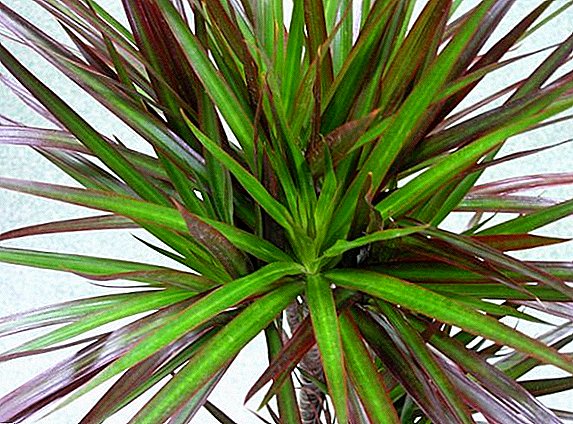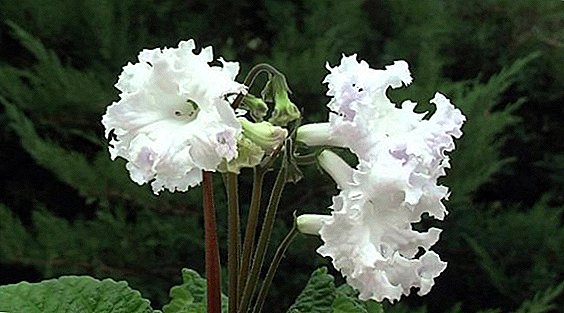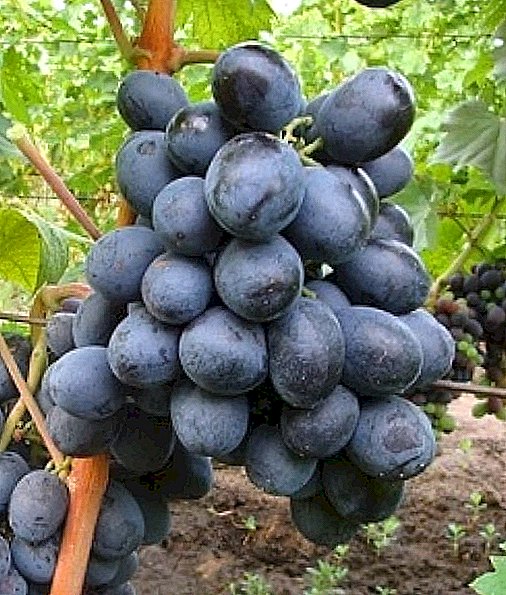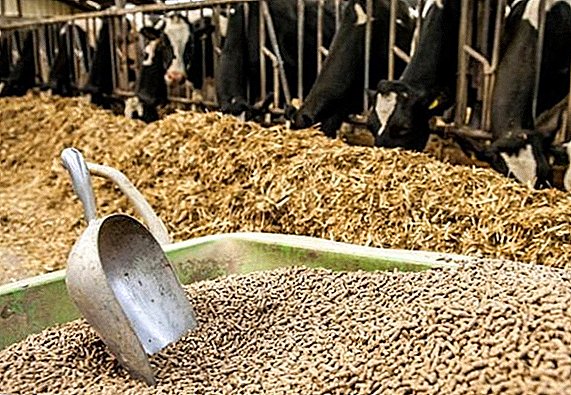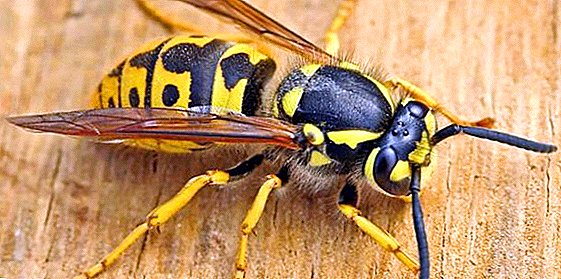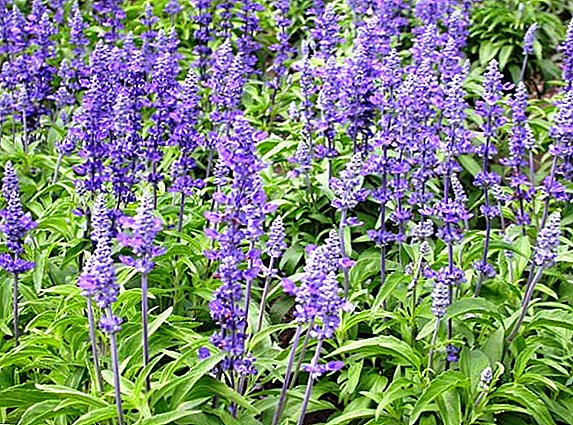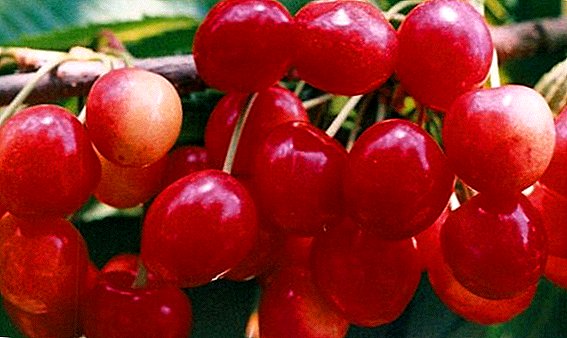 Sweet cherry is one of the most popular fruit trees, especially in the southern regions of the Eurasian continent. Its fruits ripen much earlier than others, have good transportability, and the pleasure of eating these sweet and juicy berries after a long and boring winter is simply impossible to describe! It is not surprising that more and more varieties of this tree appear every year and, having decided to plant it on their own land, it is sometimes difficult to make the best choice. We offer to get acquainted with this aristocrat among his fellows - the Franz Joseph variety (other names are "Francis" and not very harmonious "Dense Myas").
Sweet cherry is one of the most popular fruit trees, especially in the southern regions of the Eurasian continent. Its fruits ripen much earlier than others, have good transportability, and the pleasure of eating these sweet and juicy berries after a long and boring winter is simply impossible to describe! It is not surprising that more and more varieties of this tree appear every year and, having decided to plant it on their own land, it is sometimes difficult to make the best choice. We offer to get acquainted with this aristocrat among his fellows - the Franz Joseph variety (other names are "Francis" and not very harmonious "Dense Myas").
Breeding history
 Franz-Joseph I There are unfortunately no reliable data on the breeding history of this variety, as well as information about why the tree received the name of the famous Austrian emperor from the Habsburg dynasty.
Franz-Joseph I There are unfortunately no reliable data on the breeding history of this variety, as well as information about why the tree received the name of the famous Austrian emperor from the Habsburg dynasty.
Nevertheless, we know for sure that the variety came to us from Western Europe, most likely from the Czech Republic, where, in turn, appeared at the end of the 19th century.
It is believed that its author is Iosif-edward prokhewhich, by the way, was not a breeder, but a pomologist, that is, a scientist studying plant varieties. Perhaps it was the author’s own name that laid down in the name of the new variety, associating it out of modesty with the name of his great namesake.
Did you know? Sweet cherry is one of the most ancient fruit trees cultivated by man, its bones were discovered at the sites of primitive people dating back to about the eighth millennium BC, and in the 4th century before Christ, Theophrastus, an ancient Greek naturalist, mentioned the fruits of sweet cherry in his writings.
In the Soviet Union, the Czechoslovak variety began to actively look after the end of the Second World War. In 1947, this fruit tree was included in the state register, and from 1974 it began to be grown on an industrial scale mainly in the North Caucasus region, in particular, in Kabardino-Balkaria, Adygea, North Ossetia, Krasnodar and Stavropol Territories, and Karachaevo- Cherkessia.  Today "Francis" is well known, loved and successful. bred almost all over Ukraine (in particular, in Donetsk, Dnepropetrovsk, Kirovograd, Zaporizhia, Kherson, Nikolaev, Odessa, Ternopil, Khmelnytsky, Chernivtsi, Lviv, Ivano-Frankivsk and other regions), as well as in Moldova and Central Asia. Especially good European variety feels on the Crimean peninsula.
Today "Francis" is well known, loved and successful. bred almost all over Ukraine (in particular, in Donetsk, Dnepropetrovsk, Kirovograd, Zaporizhia, Kherson, Nikolaev, Odessa, Ternopil, Khmelnytsky, Chernivtsi, Lviv, Ivano-Frankivsk and other regions), as well as in Moldova and Central Asia. Especially good European variety feels on the Crimean peninsula.
In Russia, in addition to the above-mentioned regions, the tree is also grown in the Rostov region.
See also the description of the varieties of cherries: "Adeline", "Regina", "Revna", "Bryansk Pink", "Iput", "Leningradskaya Chernaya", "Fatezh", "Chermashnaya", "Krasnaya Gorka", "Ovstuzhenka", "Valery Chkalov".
Tree description
The "Franz Joseph" tree is rather large, with a not too thick crown in the shape of a wide oval. Skeletal branches are arranged in tiers, which is typical of high pyramidal crown type. The leaves are egg-shaped with an elongated end, rather large in size.
Seedlings are usually sold at one-year age, the optimum stock is steppe cherry.
Fruit Description
Fruits have a round or wide-oval shape with a distinct small groove, passing in the middle on one side (on the opposite side, it is almost invisible). The color is yellow with amber tint and bright red side or "blush" covering almost the entire surface. The flesh is also yellow, but with a pink tinge.  The size of the fruit is quite large, from 5 g to 8 g, but still this variety is inferior in size to such competitors as “Large-fruited”, “Bull-heart”, “Daibego”, “Italian”.
The size of the fruit is quite large, from 5 g to 8 g, but still this variety is inferior in size to such competitors as “Large-fruited”, “Bull-heart”, “Daibego”, “Italian”.
Important! "Franz Joseph" - this kind of cherry Biggaro, and one of his best representatives. Unlike the other species of this tree, the gini, the fruits of biggaro have dense, fleshy and crunchy flesh, the juice is transparent and colorless. These berries are better stored and are perfect for various blanks, although they ripen somewhat later. Gini - early varieties, tender and juicy, but practically not suitable for storage and transportation, they are best eaten immediately, "without departing from the tree."
Taste in "Dense Meat" sweet with spicy sourness, despite the density, very tender and juicy. According to the generally accepted five-point scale, the tasting qualities of the Franz Josef fruits are rated very high, gaining from 4.2 to 4.5 points.
Pollination
Very often, having planted a high-yielding variety of sweet cherries on the site, inexperienced gardeners wonder why the tree does not begin to bear fruit. And the reason is simple: the sweet cherry cannot be pollinated.
Important! Despite the fact that recently breeders have been trying to develop self-fertile varieties of sweet cherries, they are still very rare. As a rule, sweet cherry - cross-pollinated tree, requiring for normal yields of pollinators planted nearby, and not any, but strictly defined, suitable for this particular variety.
Sweet cherry "Franz Joseph", unfortunately, is no exception. Its fruit is better tied when planting nearby other varieties of sweet cherries. The best pollinators for her are: "Jabule", "South Coast Red", "Drogan Yellow", "Black Dyber", "Biggaro Gosha", "Early Cassina", "Golden", "Biggaro Groll", "Gedelfingen", "Denissen Yellow".  However, it should be said that even with such a joint planting sometimes it is not possible to achieve a good harvest. If such a problem arises, experienced gardeners are advised to resort to "at least" - manual pollination.
However, it should be said that even with such a joint planting sometimes it is not possible to achieve a good harvest. If such a problem arises, experienced gardeners are advised to resort to "at least" - manual pollination.
Important! Artificial pollination - the task is troublesome, but it has two indisputable advantages: it provides the highest possible yield (the fruit will be tied up practically at the place of each flower) and, in addition, protects the tree from harmful diseases, which are carried by pollinating insects (of course, if you use clean tool).
The technology of manual pollination is the topic of a separate article, here we will not dwell on it, our task is only to calm the unfortunate summer residents who have planted the high-yielding Franz Joseph on their plot and are not receiving the expected return from the tree.
Fruiting
The period of fruiting "Francis" can reach no earlier than the fourth year of life, more often - on the fifth or sixth. Nevertheless, in the first years the harvest, of course, is small, but at the age of 7-8 years old, the tree will already fully appreciate its owner.  The above characteristics of the onset of fruiting for sweet cherries are very good indicators. According to this parameter, "Franz Joseph", of course, refers to the leaders in its group, except for such varieties of sweet cherries as "Golden", "Jabule" and "Elton".
The above characteristics of the onset of fruiting for sweet cherries are very good indicators. According to this parameter, "Franz Joseph", of course, refers to the leaders in its group, except for such varieties of sweet cherries as "Golden", "Jabule" and "Elton".
Did you know? Unlike the apple tree or, for example, apricot, cherry, plum and many other fruit trees, the notion of “periodicity of fruiting” does not apply to cherries, when this year the tree produces a bountiful harvest, and during the next “goes to rest”. Having reached the fruitful age, "Franz Joseph", like his relatives, bears fruit every year, without interruption.
Gestation period
Like most biggaros, "Francis" does not belong to the early varieties of sweet cherries, but rather to the middle ones. Depending on the region, the fruits reach technical ripeness in June, and not earlier than the second decade or closer to the end of the first month of summer.
Yield
But on the yield of varieties should be said especially. Sweet cherry is generally a very prolific tree, its yield is higher than that of a cherry, at least 2, or even 3 times. But "Francis" is a unique case even for a sweet cherry.
Of course, the absolute fertility indicators depend on the region of cultivation, the age of the tree, the conditions of care and other factors, but we will call a few numbers.  On the 10-year-old tree varieties "Franz Joseph" is removed on average 35 kg of fruits, from 15-year-old - 40 kg.
On the 10-year-old tree varieties "Franz Joseph" is removed on average 35 kg of fruits, from 15-year-old - 40 kg.
Did you know? Residents of the Crimean peninsula considered that in their entire life a single tree of the Francis variety yields an average of 113 kg of crop, but the record figure is more than twice the average value - 249 kg!
If in the North Caucasus region, the yield record is measured at 30 kg per year, in Ukraine, one tree is removed per season by 60-70 kg of excellent sweet cherries.
Transportability
Another characteristic by which "Francis" is the undoubted leader is the transportability of fruits.
Important! Berries "Franz Joseph" can not just boast excellent transportability. For a long time, this particular variety was considered and continues to be considered as a kind of benchmark by which the transportable properties of other varieties of this fruit tree are measured.
Bringing new varieties of cherries, breeders are trying to achieve increased crop resistance to storage and transportation, and I must say that this task is being successfully solved. However, "Franz Joseph" continues to be among the best varieties of sweet cherry in this important indicator, especially in industrial production. 
Resistance to environmental conditions and diseases
I. Prohe brought enough resistant sweet cherry variety. The tree is relatively resistant to various environmental conditions (it suffices to recall a fairly wide area of its zoning), copes with attacks of pests. As for fungal infections, the situation here is also generally quite good. During the fruiting period, gray rot is the most dangerous for the sweet cherry (the spreader is the fungus Botrytis cinerea), which often affects the fruits in too wet weather and can greatly affect the volume and quality of the crop.
Three other malignant fossil stone crops — moniliosis, kleasterosporiosis, and coccomycosis — can also inflict certain damage on Franz Joseph. Moniliasis, or monilial burn, is dangerous for a tree to a lesser extent (one point out of three possible, that is, the probability of damage is not more than 33.3%), with two other things being a little worse: the probability of being affected by coccomycosis is 62.5%, catastrophioses, or perforated spotting - about 70%. However, compared with other varieties of sweet cherries, these figures are not such a bad result!
Useful advice for gardeners: learn how to protect the crop from birds.
Drought tolerance
Sweet cherry is a southern tree, therefore frosts are much more terrible for it than drought. It is quite enough that the plant does not experience a lack of moisture in the period when it enters the phase of active growth after the winter and begins to form fruits.  Fortunately, it is usually just at this time that the water in the ground is sufficient; on the contrary, they begin to crack because of an overabundance of moisture during the ripening of the berries. This is the perennial problem of cherry growers. A tree should be plentifully watered in the middle of autumn, but the purpose of this procedure is to help the cherries survive the difficult time for it - the winter, because, as you know, dry land freezes through more.
Fortunately, it is usually just at this time that the water in the ground is sufficient; on the contrary, they begin to crack because of an overabundance of moisture during the ripening of the berries. This is the perennial problem of cherry growers. A tree should be plentifully watered in the middle of autumn, but the purpose of this procedure is to help the cherries survive the difficult time for it - the winter, because, as you know, dry land freezes through more.
Nevertheless, among other varieties of sweet cherry “Frans Joseph” is not distinguished by drought resistance, and in this parameter is inferior to such varieties as “Kitaevskaya Chernaya”, “Krupnoplodnaya”, “Polyanka”, “Priusadebnaya”, “Russkaya”, “Melitopol Early”, and even less drought-resistant varieties such as the Bahor, Biggaro Napoleon White, Biggaro Oratovsky, Vinka and Vystavochnaya.
Winter hardiness
Everything is good in the cherry - and the yield and taste of the fruit, and even resistance to pests and diseases. One problem: trees can hardly stand frost. For this reason, for a long time, sweet cherries were grown exclusively in the southern regions and remained virtually inaccessible even for the Central zone. It is for this reason that breeders have directed all efforts to promote the cherry, at least a little to the north.
"Franz Joseph" - one of the first such attempts. If you recall the map, it will become clear that the Czech Republic is the birthplace of the variety — it is located much to the north of the Crimea, in winter it is quite cold there (down to -30 ° C!), And heavy snowfall often gives way to thaws and new frosts, and when the temperature rises, often sharp , sometimes heavy winds. All this is not very familiar conditions for the southern fruit trees, however, "Franz Joseph" was developed in such climatic conditions.  By existing standards, "Francis" is still taken to refer to varieties of medium frost resistance, since recently there are varieties of sweet cherries that can grow much more to the north.
By existing standards, "Francis" is still taken to refer to varieties of medium frost resistance, since recently there are varieties of sweet cherries that can grow much more to the north.
Important! The most winter-hardy varieties of sweet cherries are Leningradskaya Roza, Heart, and the Estonian representative of the species, Meelika.
In this regard, when grown in cold winters, young saplings strongly recommend covering for the winter during the first two years of life, and also, as already mentioned, take care of preparing the ground for frost (heavy watering to a depth of at least 40 cm and subsequent mulching of the near-barrel circle to prevent evaporation of moisture).
It has been observed that already at a temperature below -23 ° C more than half of the Franz Joseph flower buds die, although the wood itself suffers frost without damage. But at lower temperatures, both the trunk and skeletal branches can freeze slightly.
There is a hybrid of cherries and cherries, which is called "cherry".
Fruit use
As it was said, the fruits of "Francis" have excellent taste and are great for fresh use (Fortunately, they are well transported and stored).  But the main advantage of the variety (as well as other biggaro cherries) is that its fruit can also be used to make excellent jams and compotes, since their dense pulp does not fall apart during heat treatment, like that of guinea cherries.
But the main advantage of the variety (as well as other biggaro cherries) is that its fruit can also be used to make excellent jams and compotes, since their dense pulp does not fall apart during heat treatment, like that of guinea cherries.
Did you know? In the Middle Ages, the word "cerasus" was called both cherry and sweet cherry, but in the first case the epithet "sour" was added to the name, in another - "sweet". In English, by the way, there is still confusion about these two fruits. - both are denoted by the word "cherry". With regard to cherries, however, the phrase "sweet cherries" (that is, again, sweet cherry) is often used, and when people talk about cherries, they specify "tart cherries" (that is, cherry, but tart). However, perhaps the problem is that in America and in England the sweet cherry - not such a familiar delicacy, as in the south of Ukraine, that people do not understand the difference.
Sweet cherry varieties "Franz Joseph" can also be dried. This is a great way to cope with a huge harvest, and believe me, these fruits are not inferior in taste to raisins and dried apricots, but this is much more original. But use the advice: so that when harvesting all the precious juice does not flow out of the fruit: the stone should not be removed before, but after drying. Add dried sweet cherries to your favorite cupcake - and your homemade ones will be pleasantly surprised by the new and unusual flavor. 
Learn how to dry oranges, plums, grapes, strawberries, currants, apples, pears, cranberries, blueberries, rosehip, dogwood.
Advantages and disadvantages
From the above detailed description of the variety, one can summarize the main advantages and disadvantages of the Franz Josef sweet cherry.
pros
- High productivity.
- Excellent transportability (almost reference).
- The early period of onset of fruiting.
- High taste and appearance qualities of fruits, rather large in size.
- A wide field for the application of the harvest - the use of raw, as well as use as blanks.
- High frost resistance of vegetative organs.

Minuses
- Average winter hardiness (not suitable for growing in cold regions).
- Relatively low drought tolerance.
- Average keeping quality of fruits.
- With similar indicators of transportability, there are more large-fruited varieties.
- During prolonged rains during the fruiting period, sweet cherries are affected by gray rot and crack.
- Not capable of self-pollination.
- Relatively late maturation (second half of June).
"Franz Joseph" is a sweet cherry tree, which, of course, should be planted on your plot if you live not north of the Volgograd region of Russia or the Czech Republic in Europe. With proper and fairly simple care and the presence of pollinating neighbors, this aristocratic variety will surely please you if not very early, but very abundant and tasty harvest, the surplus of which you can easily save as blanks until winter.


